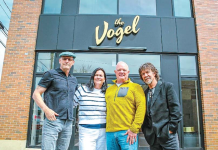By Philip Sean Curran
FREEHOLD – A short walk down a hallway and through an entrance inside the Monmouth County Sheriff’s Office public safety center in Freehold leads to the 911 communications center, a large room filled with computer and video screens.
Dispatchers work behind desks with six screens each, ready to receive a call that might involve a life-or-death emergency happening somewhere in Monmouth County at any hour of the day. Thanks to an internet-based application from technology company RapidSOS, first responders are getting more accurate information about the location where those calls are being made.
Toward the end of 2018, the sheriff’s office announced it was using RapidSOS, which grabs the GPS information from cell phones to pinpoint caller locations. Other law enforcement agencies around the country use it as well, a way to speed up response times and save lives. The sheriff’s office, responsible for dispatch services for about 150 agencies in the county, was the first in New Jersey to implement the technology.
911 calls from landline phones still show the address associated with the landline, but cell phones, used in 80 percent of all service calls the county facility received last year, do not.
“In the traditional 911 system in New Jersey, we don’t have an accurate location,” for calls from a cell phone, Sheriff Shaun Golden said. “We have cell tower locations,” meaning when a 911 call came in from a cell phone, the best “address” officials would get was a geographic radius from the cell tower transmitting the call. And if a caller was driving and/or unfamiliar with the area, location information was even more difficult to pinpoint.
“We would get people that would drive by accidents or be in a town that they’re not familiar or a shopping mall they’re not familiar with,” he said. “We would be able to ping the phone, but not to an exact location. And so, every day we would see those types of calls come into the center.”
Now, when a call from a cell phone comes in, dispatchers are able to locate the caller on an electronic map pinpointing a location, either indoors or out. The RapidSOS system works with iPhones using iOS 12 or later software and Android phones version 4.0 or higher, according to the sheriff’s office.
While a comparison of response times before and after RapidSOS went into effect was not available, Golden said the system has helped “tremendously.”
911 dispatchers like Ross Martin agree.
“You don’t know what you’re going to get every day, you don’t know what you’re going to get from one call to another,” he said. “So this makes it easier for us as dispatchers.”

RapidSOS is just one way the sheriff’s office – and the larger law enforcement community around the country – is using technology to do its job. On the same day Golden was showing how the system works, members of his department were outside the building working with a drone.
At the police academy his office runs, officials provided recruits with iPad tablets, meaning they no longer had paper law books or note pads during their training period.
“But they want that,” Golden said. “That’s that generation. They grew up multitasking on smart phones.”
Red Bank Police Chief Darren McConnell recalled that when he started out in law enforcement in the late 1980s, squad car radios were the latest technology.
“Now we have cameras in our cars, we have laptops in our cars,” he said. “We can look up anything, practically, at our fingertips real time.”
From the safety of their vehicles, officers can check law enforcement data bases to see if someone has an active warrant or is on a terrorist watch list, among other things.
“It is a different generation, so the officers that are newer grew up that way, grew up on computers and technology,” he said. “Whereas the ones from my generation or before my generation did not. So there was more of a learning curve.”
Yet for law enforcement agencies, staying current with technology has become a part of the job, along with finding the money to pay for it.
“I think the challenge is for the smaller departments to keep up with it,” said John G. Comiskey, a professor of criminal justice at Monmouth University. “Monmouth County is the exception. And I think part of it is because of the money. They’re (the) 38th most wealthy county. And I think you get a similar size town in Alabama, they wouldn’t have the money to do some of those things.” In recent years, there was a push to have law enforcement wear body cameras. The devices are not that expensive, said Comiskey, a former New York City police officer.
“But now, you’re going to have to serialize and retain all of that data and storage and maintain servers,” he said, also noting the related manpower costs involved.
In 2014 the county opened the public safety center, a 45,000-square-foot facility, at a building cost of $23.2 million. At the facility the county provides dispatch services for half the police departments in Monmouth and other agencies, processing some 780,000 calls in 2018, of which roughly 200,000 were 911 calls.
“You’re talking about a state-of-the-art 911 facility, despite the lack of funding from the state of New Jersey now for over 10 years,” Golden said. “We’re at the mercy of the state with the 911 infrastructure.”
He was referring to how the state has diverted money coming from fees cellphone users pay on their monthly bills that should be going to 911 facilities. It’s an issue Golden has raised in the past. As a result, he turned to the private sector, like RapidSOS, to fill those gaps.
Golden pointed to the value of shared service agreements that his office has with other first responder agencies in the county to provide their dispatch services. He said Middletown, one of the partner agencies with his office, wound up saving almost $1 million a year by having the county handle that critical function.
“It’s the technology that really gives you the economies of scale and efficiency,” he said.
So where does Golden’s office go next for technology? “The next tech step is looking at streaming video and photographs from scenes into the dispatcher, so the dispatcher can then get an accurate picture of what’s going on,” he said. “That’s where technology is going.”
In such a scenario, the 911 caller would have to give permission for the dispatcher, through a text message, to use the caller’s phone camera to view the scene. Golden’s office is in the middle of testing the technology and expects to be able to deploy it “by the end of this year, beginning of next year,” he said.
Asked about Big Brother concerns, Golden said, “We always keep that in mind. That’s why the policy and procedures have to be such that we address those issues before we roll out a technology like that.”














